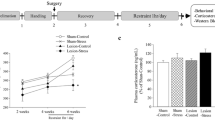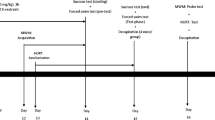Abstract
The cholinergic neurotransmitter system and prolonged glucocorticoid-induced stress can affect cognitive functions in opposite ways. While pharmacological enhancement of cholinergic neurotransmission is known to induce neuroprotective effects, chronic glucocorticoids impair cognitive functions. Up to now, there is no consensus as to whether a subchronic stress period of several days would affect cognitive function. The goal of this study was to investigate whether or not repeated applications of physostigmine over 3 days lead to protective effects on rat spatial cognitive abilities in contrast to the deteriorating effect on rat cognitive function after corticosterone treatment. Furthermore, we wanted to investigate in what extent this cognition-modulating effect is associated with rat cerebral acetylcholinergic system. Male adult rats (n = 40) were randomly divided into four groups with n = 10 per group: (I) placebo-, (II) corticosterone- (15 mg/day), (III) physostigmine- (0.014 mg/day), and (IV) physostigmine + corticosterone-treated rats. Body mass and plasma corticosterone concentrations were measured. Psychometric investigations were conducted using a Morris water maze before and after a subchronic treatment. In cerebral tissue, ACh and acetylcholinesterase (AChE) content and ACh receptor density were determined. Tissue corticosterone concentration was measured in cerebral cortex, hippocampus, and adrenal glands. In corticosterone-treated rats, reduced spatial cognitive abilities were associated with a significant increase in plasma (+25%) and cerebral corticosterone levels (+350%) parallelled by a significant reduction in adrenal gland concentrations (−84%) as compared to placebo. Repeated physostigmine injections improved rats’ spatial memory and increased cerebral ACh and AChE content (p < 0.05). When physostigmine was administered at the same time as corticosterone (group IV), it was not able to reverse the corticosterone effect. A significant correlation was detected between cerebral AChE and corticosterone concentrations as well as between AChE and psychometric parameters. We conclude that subchronic exogenous corticosterone administration induces memory dysfunction whereas physostigmine exerts cognitive-enhancing effects if given for 3 days. An apparently existing interaction between glucocorticoid excess and ACh metabolism is discussed.






Similar content being viewed by others
References
Aracava Y, Deshpande SS, Rickett DL, Brossi A, Schonenberger B, Albuquerque EX (1987) The molecular basis of anticholinesterase actions on nicotinic and glutamatergic synapses. Ann NY Acad Sci 505:226–255
Bardgett ME, Taylor GT, Csernansky JG, Newcomer JW, Nock B (1994) Chronic corticosterone treatment impairs spontaneous alternation behavior in rats. Behav Neural Biol 61:186–190
Bertrand D, Valera S, Bertrand S, Ballivet M, Rungger D (1991) Steroids inhibit nicotinic acetylcholine receptors. Neuroreport 2:277–280
Birks J (2006) Cholinesterase inhibitors for Alzheimer’s disease. Cochrane Database Syst Rev CD005593
Braun S, Askanas V, Engel WK, Ibrahim EN (1993) Long-term treatment with glucocorticoids increases synthesis and stability of junctional acetylcholine receptors on innervated cultured human muscle. J Neurochem 60:1929–1935
Brown DV, Heller F, Barkin R (2004) Anticholinergic syndrome after anesthesia: a case report and review. Am J Ther 11:144–153
Coburn-Litvak PS, Pothakos K, Tata DA, McCloskey DP, Anderson BJ (2003) Chronic administration of corticosterone impairs spatial reference memory before spatial working memory in rats. Neurobiol Learn Mem 80:11–23
Coelho F, Birks J (2001) Physostigmine for Alzheimer’s disease. Cochrane Database Syst Rev CD001499
Dai J, Buijs R, Swaab D (2004) Glucocorticoid hormone (cortisol) affects axonal transport in human cortex neurons but shows resistance in Alzheimer’s disease. Br J Pharmacol 143:606–610
de Haan M, van Herck H, Tolboom JB, Beynen AC, Remie R (2002) Endocrine stress response in jugular-vein cannulated rats upon multiple exposure to either diethyl-ether, halothane/O2/N2O or sham anaesthesia. Lab Anim 36:105–114
de Kloet ER, Oitzl MS, Joels M (1999) Stress and cognition: are corticosteroids good or bad guys? Trends Neurosci 22:422–426
De Sarno P, Giacobini E (1989) Modulation of acetylcholine release by nicotinic receptors in the rat brain. J Neurosci Res 22:194–200
de Quervain DJ, Poirier R, Wollmer MA, Grimaldi LM, Tsolaki M, Streffer JR, Hock C, Nitsch RM, Mohajeri MH, Papassotiropoulos A (2004) Glucocorticoid-related genetic susceptibility for Alzheimer's disease. Hum Mol Genet 13:47–52
Diamond DM, Park CR, Heman KL, Rose GM (1999) Exposing rats to a predator impairs spatial working memory in the radial arm water maze. Hippocampus 9:542–552
Erb C, Troost J, Kopf S, Schmitt U, Loffelholz K, Soreq H, Klein J (2001) Compensatory mechanisms enhance hippocampal acetylcholine release in transgenic mice expressing human acetylcholinesterase. J Neurochem 77:638–646
Feldmann RE Jr, Maurer MH, Hunzinger C, Lewicka S, Buergers HF, Kalenka A, Hinkelbein J, Broemme JO, Seidler GH, Martin E, Plaschke K (2008) Reduction in rat phosphatidylethanolamine binding protein-1 (PEBP1) after chronic corticosterone treatment may be paralleled by cognitive impairment: a first study. Stress 11:134–147
Flood JF, Vidal D, Bennett EL, Orme AE, Vasquez S, Jarvik ME (1978) Memory facilitating and anti-amnesic effects of corticosteroids. Pharmacol Biochem Behav 8:81–87
Goto K, Chiba Y, Sakai H, Misawa M (2008) Glucocorticoids inhibited airway hyperresponsiveness through downregulation of CPI-17 in bronchial smooth muscle. Eur J Pharmacol 591:231–236
Hauger RL, Millan MA, Catt KJ, Aguilera G (1987) Differential regulation of brain and pituitary corticotropin-releasing factor receptors by corticosterone. Endocrinology 120:1527–1533
Herbert J, Goodyer IM, Grossman AB, Hastings MH, de Kloet ER, Lightman SL, Lupien SJ, Roozendaal B, Seckl JR (2006) Do corticosteroids damage the brain? J Neuroendocrinol 18:393–411
Hofer S, Eisenbach C, Lukic IK, Schneider L, Bode K, Brueckmann M, Mautner S, Wente MN, Encke J, Werner J, Dalpke AH, Stremmel W, Nawroth PP, Martin E, Krammer PH, Bierhaus A, Weigand MA (2008) Pharmacologic cholinesterase inhibition improves survival in experimental sepsis. Crit Care Med 36:404–408
Holsboer F, Barden N (1996) Antidepressants and hypothalamic-pituitary-adrenocortical regulation. Endocr Rev 17:187–205
Joels M, Pu Z, Wiegert O, Oitzl MS, Krugers HJ (2006) Learning under stress: how does it work? Trends Cogn Sci 10:152–158
Karssen AM, Meijer OC, van der Sandt IC, Lucassen PJ, de Lange EC, de Boer AG, de Kloet ER (2001) Multidrug resistance P-glycoprotein hampers the access of cortisol but not of corticosterone to mouse and human brain. Endocrinology 142:2686–2694
Karuri AR, Engelking LR, Kumar MS (1998) Effects of halothane and methoxyflurane on the hypothalamic-pituitary-adrenal axis in rat. Brain Res Bull 47:205–209
Kaufer D, Friedman A, Seidman S, Soreq H (1998) Acute stress facilitates long-lasting changes in cholinergic gene expression. Nature 393:373–377
Kaufer D, Friedman A, Seidman S, Soreq H (1999) Anticholinesterases induce multigenic transcriptional feedback response suppressing cholinergic neurotransmission. Chem Biol Interact 119–120:349–360
Li Y, Camp S, Rachinsky TL, Bongiorno C, Taylor P (1993) Promoter elements and transcriptional control of the mouse acetylcholinesterase gene. J Biol Chem 268:3563–3572
Maelicke A, Coban T, Schrattenholz A, Schroder B, Reinhardt-Maelicke S, Storch A, Godovac-Zimmermann J, Methfessel C, Pereira EF, Albuquerque EX (1993) Physostigmine and neuromuscular transmission. Ann NY Acad Sci 681:140–154
Mandel RJ, Thal LJ (1988) Physostigmine improves water maze performance following nucleus basalis magnocellularis lesions in rats. Psychopharmacology (Berl) 96:421–425
Marklund N, Peltonen M, Nilsson TK, Olsson T (2004) Low and high circulating cortisol levels predict mortality and cognitive dysfunction early after stroke. J Intern Med 256:15–21
McEwen BS, Sapolsky RM (1995) Stress and cognitive function. Curr Opin Neurobiol 5:205–216
Meshorer E, Erb C, Gazit R, Pavlovsky L, Kaufer D, Friedman A, Glick D, Ben-Arie N, Soreq H (2002) Alternative splicing and neuritic mRNA translocation under long-term neuronal hypersensitivity. Science 295:508–512
Morris R (1984) Developments of a water-maze procedure for studying spatial learning in the rat. J Neurosci Methods 11:47–60
Murialdo G, Nobili F, Rollero A, Gianelli MV, Copello F, Rodriguez G, Polleri A (2000) Hippocampal perfusion and pituitary-adrenal axis in Alzheimer’s disease. Neuropsychobiology 42:51–57
Newcomer JW, Craft S, Hershey T, Askins K, Bardgett ME (1994) Glucocorticoid-induced impairment in declarative memory performance in adult humans. J Neurosci 14:2047–2053
O’Brien JT, Ames D, Schweitzer I, Colman P, Desmond P, Tress B (1996) Clinical and magnetic resonance imaging correlates of hypothalamic-pituitary-adrenal axis function in depression and Alzheimer’s disease. Br J Psychiatry 168:679–687
Osmanovic J, Plaschke K, Salkovic-Petrisic M, Grunblatt E, Riederer P, Hoyer S (2010) Chronic exogenous corticosterone administration generates an insulin-resistant brain state in rats. Stress 13:123–131
Paterson D, Nordberg A (2000) Neuronal nicotinic receptors in the human brain. Prog Neurobiol 61:75–111
Pinnock SB, Herbert J (2001) Corticosterone differentially modulates expression of corticotropin releasing factor and arginine vasopressin mRNA in the hypothalamic paraventricular nucleus following either acute or repeated restraint stress. Eur J Neurosci 13:576–584
Plaschke K, Feindt J, Djuric Z, Heiland S, Autschbach F, Lewicka S, Martin E, Bardenheuer HJ, Nawroth PP, Bierhaus A (2006) Chronic corticosterone-induced deterioration in rat behaviour is not paralleled by changes in hippocampal NF-kappaB-activation. Stress 9:97–106
Plaschke K, Staub J, Ernst E, Marti HH (2008) VEGF overexpression improves mice cognitive abilities after unilateral common carotid artery occlusion. Exp Neurol 214:285–292
Plaschke K, Frauenknecht K, Sommer C, Heiland S (2009) A single systemic transient hypotension induces long-term changes in rats’ MRI parameters and behavior: relation to aging. Neurol Res 31:304–312
Plotsky PM, Owens MJ, Nemeroff CB (1998) Psychoneuroendocrinology of depression. Hypothalamic-pituitary-adrenal axis. Psychiatr Clin North Am 21:293–307
Rhodes ME, O’Toole SM, Wright SL, Czambel RK, Rubin RT (2001) Sexual diergism in rat hypothalamic-pituitary-adrenal axis responses to cholinergic stimulation and antagonism. Brain Res Bull 54:101–113
Riley EP, Barron S, Driscoll CD, Hamlin RT (1986) The effects of physostigmine on open-field behavior in rats exposed to alcohol prenatally. Alcohol Clin Exp Res 10:50–53
Sadowski RN, Jackson GR, Wieczorek L, Gold PE (2009) Effects of stress, corticosterone, and epinephrine administration on learning in place and response tasks. Behav Brain Res 205:19–25
Sandi C (2004) Stress, cognitive impairment and cell adhesion molecules. Nat Rev Neurosci 5:917–930
Sandi C, Loscertales M (1999) Opposite effects on NCAM expression in the rat frontal cortex induced by acute vs chronic corticosterone treatments. Brain Res 828:127–134
Shaked I, Zimmerman G, Soreq H (2008) Stress-induced alternative splicing modulations in brain and periphery: acetylcholinesterase as a case study. Ann NY Acad Sci 1148:269–281
Shapira M, Tur-Kaspa I, Bosgraaf L, Livni N, Grant AD, Grisaru D, Korner M, Ebstein RP, Soreq H (2000) A transcription-activating polymorphism in the ACHE promoter associated with acute sensitivity to anti-acetylcholinesterases. Hum Mol Genet 9:1273–1281
Somani SM, Khalique A (1986) Distribution and pharmacokinetics of physostigmine in rat after intramuscular administration. Fundam Appl Toxicol 6:327–334
Somani SM, Khalique A (1987) Pharmacokinetics and pharmacodynamics of physostigmine in the rat after intravenous administration. Drug Metab Dispos 15:627–633
Sternfeld M, Shoham S, Klein O, Flores-Flores C, Evron T, Idelson GH, Kitsberg D, Patrick JW, Soreq H (2000) Excess “read-through” acetylcholinesterase attenuates but the “synaptic” variant intensifies neurodeterioration correlates. Proc Natl Acad Sci USA 97:8647–8652
Stratakis CA, Chrousos GP (1995) Neuroendocrinology and pathophysiology of the stress system. Ann NY Acad Sci 771:1–18
Treit D, Fundytus M (1988) Thigmotaxis as a test for anxiolytic activity in rats. Pharmacol Biochem Behav 31:959–962
van Dyck CH, Newhouse P, Falk WE, Mattes JA (2000) Extended-release physostigmine in Alzheimer disease: a multicenter, double-blind, 12-week study with dose enrichment Physostigmine Study Group. Arch Gen Psychiatry 57:157–164
van Marum RJ (2008) Current and future therapy in Alzheimer’s disease. Fundam Clin Pharmacol 22:265–274
Vanitallie TB (2002) Stress: a risk factor for serious illness. Metabolism 51:40–45
Vecsei P (1979) Glucocorticoids: cortisol, cortisone, corticosterone, compound S and their metabolites. In: Jaffe BM, Behrmann HR (eds) Methods of hormone radioimmunoassays. Academic Press, New York, pp 767–792
Vollmayr B, Faust H, Lewicka S, Henn FA (2001) Brain-derived-neurotrophic-factor (BDNF) stress response in rats bred for learned helplessness. Mol Psychiatry 6:471–474, 358
Wolf OT (2003) HPA axis and memory. Best Pract Res Clin Endocrinol Metab 17:287–299
Woolley CS, Gould E, McEwen BS (1990) Exposure to excess glucocorticoids alters dendritic morphology of adult hippocampal pyramidal neurons. Brain Res 531:225–231
Young AH, Sahakian BJ, Robbins TW, Cowen PJ (1999) The effects of chronic administration of hydrocortisone on cognitive function in normal male volunteers. Psychopharmacology (Berl) 145:260–266
Acknowledgments
The authors would like to thank Roland Galmbacher, Sigrun Himmelsbach, Lubomira Majernikova and Klaus Stefan for their support.
Conflict of Interest
All authors declare that they have no conflicts of interest.
Author information
Authors and Affiliations
Corresponding author
Rights and permissions
About this article
Cite this article
Wüppen, K., Oesterle, D., Lewicka, S. et al. A subchronic application period of glucocorticoids leads to rat cognitive dysfunction whereas physostigmine induces a mild neuroprotection. J Neural Transm 117, 1055–1065 (2010). https://doi.org/10.1007/s00702-010-0441-4
Received:
Accepted:
Published:
Issue Date:
DOI: https://doi.org/10.1007/s00702-010-0441-4




